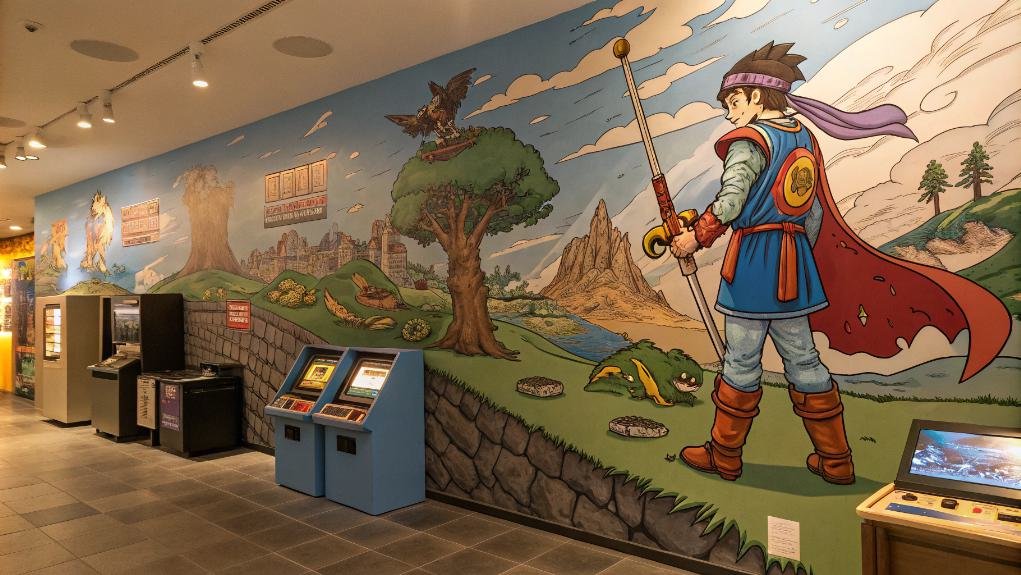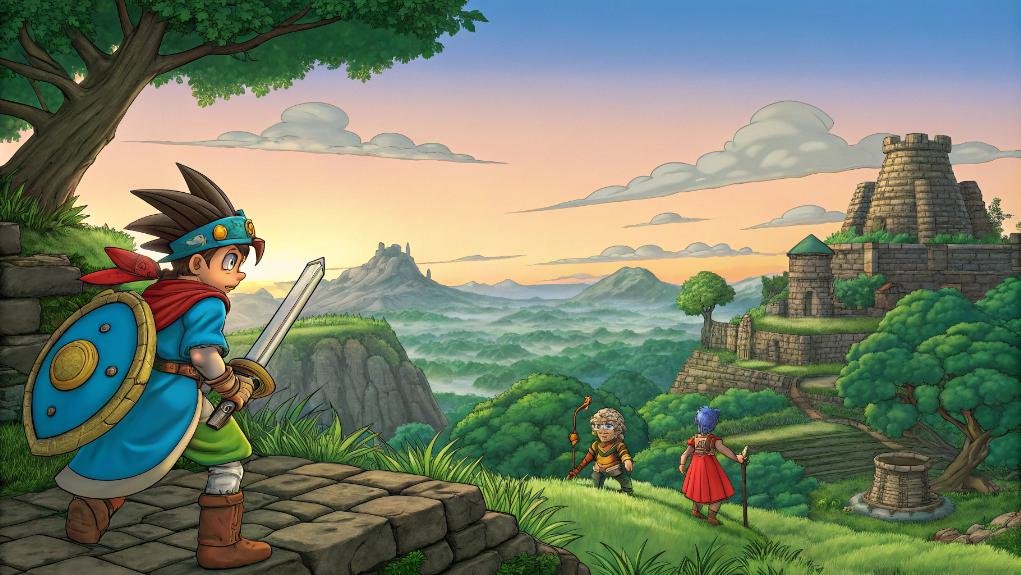Dragon Quest I, released in Japan in 1986, revolutionized the RPG genre, establishing critical frameworks for storytelling and gameplay. It introduced turn-based combat and a single-player focus, enhancing player engagement through exploration and character development. Its cultural impact, bolstered by Akira Toriyama's iconic character design and Koichi Sugiyama's memorable music, embedded it in Japanese pop culture. The game's success led to regional adaptations, like its North American release as Dragon Warrior, which faced localization challenges yet maintained its core appeal. This monumental title set standards anticipated in subsequent RPGs, a legacy worth exploring further.
Key Takeaways
- Released in 1986, Dragon Quest I set the foundation for future RPGs with its compelling storytelling and engaging gameplay mechanics.
- The game introduced turn-based combat and character development, fostering strategic planning and exploration within its narrative-rich environment.
- Cultural icons like Akira Toriyama's character designs and Koichi Sugiyama's music contributed to the game's lasting impact on Japanese pop culture.
- Regional adaptations, notably the name change to Dragon Warrior in North America, faced challenges that shaped the game's accessibility and reception.
- Dragon Quest I's success established genre standards, influencing subsequent RPGs and creating a dedicated following that persists today.
Creation and Development

However, programming challenges arose, particularly with the Famicom's storage limitations, forcing Horii to prioritize content.
He emphasized creating a compelling atmosphere and integrating engaging narratives, using techniques from visual novels. The game's development was influenced by the success of earlier titles in the Dragon Quest series, showcasing the importance of storytelling in role-playing games.
Balancing text and graphics became essential, ensuring players could connect with the story while maneuvering through the game's mechanics.
Ultimately, these strategic collaborations and innovative approaches laid the foundation for Dragon Quest's enduring legacy in the gaming world.
Gameplay and Design Elements
In examining the gameplay and design elements of Dragon Quest I, it's clear that early mechanics laid the foundation for future innovations. Players engage in turn-based combat, balancing strategy and chance as they navigate the storyline and objectives. The integration of character development and exploration not only enriches the experience but also establishes a framework that would evolve throughout the series. Additionally, understanding turn order mechanics enhances strategic planning during battles, as players must consider agility and random chance to optimize their actions.
Game Mechanics Overview
Dragon Quest I set the foundation for a series renowned for its engaging gameplay mechanics and design elements. The turn-based combat system introduced a strategic layer, where players could develop battle strategies against random encounters. Additionally, the introduction of multi-enemy encounters in later installments expanded the tactical possibilities for players in combat.
Character progression is central to gameplay, as defeating monsters earns experience points, leading to level increases and improved stats like HP and Strength. Exploration mechanics allow players to navigate towns, dungeons, and expansive world maps, while NPC interactions enrich the experience, offering essential information, items, and services.
Game difficulty remains balanced, challenging players without overwhelming them, which encourages exploration and experimentation. Stat management plays an important role in combat systems, influencing performance in battles.
The graphical evolution from 2D to 3D environments in later installments reflects the series' commitment to enhancing player immersion. As each game built upon its predecessor, innovative features like the Tactics system and class systems emerged, adding depth to character and party development.
Storyline and Objectives
Building on the solid gameplay mechanics introduced in Dragon Quest I, the storyline and objectives create a compelling narrative that drives player engagement. Set in the Kingdom of Alefgard, players assume the role of a hero tasked with rescuing Princess Gwaelin from the Dragonlord. The protagonist, a descendant of the legendary Erdrick, follows ancient tablets that outline vital steps to confront the main antagonist. This journey not only emphasizes character motivations but also invites players to engage in their own narrative interpretation. Notably, the game was influenced by the RPG Wizardry, which helped shape its accessible gameplay design.
| Key Objectives | Gameplay Elements | Design Influences |
|---|---|---|
| Rescue Princess Gwaelin | Gather weapons and armor | Minimalistic storytelling |
| Retrieve the Ball of Light | Speak with villagers for clues | Room for creative interpretation |
| Create a magical bridge | Explore a variety of locations | Simple design due to technological limits |
| Confront the Dragonlord | Defeat monsters for experience | Evolved complexity in later titles |
| Restore light to Alefgard | Nonlinear objective choices | Progression towards defined narratives |
This blend of objectives and gameplay fosters a rich experience, encouraging players to explore the world while crafting their own unique story.
Impact and Legacy

Transforming the landscape of role-playing games, *Dragon Quest I* established a framework that not only defined the genre but also set expectations for future titles. Its influence analysis reveals how it popularized the console JRPG genre, introducing accessible gameplay that appealed to all ages. The game set standards with its turn-based combat, character progression through experience points, and a narrative-driven structure, laying the groundwork for genre evolution. Elements like quests, monsters, and plot devices became staples in RPGs, with *Dragon Quest I* adeptly translating *Dungeons & Dragons*-style concepts into a console format. The game is often regarded as the forefather of all JRPGs, highlighting its foundational role in shaping the genre.
Its legacy extends beyond gaming, inspiring various media, including *Yakuza: Like a Dragon*, which adopted its turn-based mechanics. The game's enduring appeal is showcased through its presence in *Super Smash Bros. Ultimate* and its continued relevance via ports and re-releases on modern consoles. Despite critiques of formulaic design, the series has evolved while remaining true to its roots. *Dragon Quest I* not only influenced future RPGs but also shaped broader gaming culture, ensuring its impact is felt across genres and generations.
Releases and Localizations
The releases and localizations of Dragon Quest I highlight significant differences and challenges that shaped its reception in various markets.
While the original Famicom version embraced traditional RPG elements, the North American adaptation faced hurdles, including a name change to Dragon Warrior and alterations in gameplay to cater to a different audience. This adaptation was critical as it marked the beginning of Dragon Quest's influence on the RPG genre, which would later expand into a mainstream phenomenon.
These regional naming variations and localization strategies not only affected the game's early performance but also set the stage for future efforts in making the series more accessible to international players.
Initial Release Differences
How did *Dragon Quest I* navigate the complexities of initial releases and localizations across different platforms? The game first launched in Japan on the MSX and Famicom in 1986, showcasing innovative gameplay features such as first-person battles and an accessible design.
When it shifted to North America in 1989, it was rebranded as *Dragon Warrior* due to copyright issues, a change that would impact its recognition among fan communities. North American players experienced improved graphics and a battery-backed save feature, contrasting with the Japanese version's password system.
Subsequent ports to platforms like the Super Famicom and Game Boy Color allowed *Dragon Quest I* to reach a wider audience, but the name change complicated series continuity in the West. The game not only introduced turn-based RPG mechanics but also set the stage for the success of future titles in the genre.
The game adaptations that followed built on its success, paving the way for RPGs on consoles. Despite initial limited success in North America, *Dragon Quest* became a cultural phenomenon in Japan, influencing future titles in the genre.
The journey of *Dragon Quest I* exemplifies the challenges and triumphs of bringing a beloved game across different regions and platforms, ultimately shaping its legacy in the gaming world.
Localization Challenges Faced
While maneuvering through the complexities of localization, *Dragon Quest I* faced numerous challenges that considerably impacted its reception in various markets. One significant hurdle was the character limits imposed by the Game Boy, which restricted translations to a mere 18 characters per line. This constraint necessitated abbreviation strategies, leading to item names like "Princess' Love" being shortened to "LoraLuv."
To maximize space, developers employed icon usage, replacing lengthy item descriptions with symbols such as the Iron ⚔.
Cultural adaptation posed additional issues, as early localizations had to navigate religious censorship, changing "churches" to "Houses of Healing." This alteration, along with other lexical changes, aimed to make the game more palatable to Western audiences. Mixed fan feedback emerged, with older players lamenting these modifications while younger fans embraced the new style. Moreover, the translation philosophies employed in different versions influenced how these changes were perceived, highlighting the subjective nature of localization.
Over time, localization evolution improved, incorporating better translation techniques and a more consistent canon for names. As Square Enix refined its approach, it increasingly relied on fan feedback, striking a balance between creativity and faithfulness to the original text.
Ultimately, these challenges shaped the perception and legacy of *Dragon Quest I* in international markets.
Regional Naming Variations
Localization challenges not only shaped the perception of *Dragon Quest I* but also influenced its naming across different regions. The series faced significant name differences due to trademark issues, particularly in North America, where it was branded as "Dragon Warrior" to avoid conflicts with an unrelated tabletop RPG. This early localization strategy affected how players perceived the franchise.
- Cultural adaptations resulted in character and location name changes, impacting player engagement.
- Branding evolution began with the registration of the "Dragon Quest" trademark in the U.S. in 2002, setting the stage for consistency, and this evolution reflects the streamlined naming seen in modern remakes.
- The transitional period marked a shift towards more faithful translations, especially with the release of *Dragon Quest VIII* in 2004.
- Modern releases now focus on preserving the integrity of the original Japanese content, ensuring that regional perceptions align more closely with the source material.
These variations highlight the importance of localization in shaping a game's identity and how such efforts have unified the *Dragon Quest* series globally, enhancing its recognition and appeal across diverse audiences.
Sequels and Continuations

The legacy of Dragon Quest I paved the way for a series of sequels and continuations that expanded its universe and deepened its storytelling.
Dragon Quest II, set 100 years later, introduced new characters and further developed the world established in the first game. Conversely, Dragon Quest III serves as a prequel, exploring the origins of the saga and enriching the narrative tapestry of The Erdrick Saga, which encompasses all three titles. This prequel is particularly noteworthy as it is currently available for purchase as an HD-2D Remake, allowing players to experience its story with updated visuals and mechanics.
As the series evolved, subsequent entries like Dragon Quest IV and V introduced fresh protagonists and innovative gameplay mechanics, enhancing character evolution.
The fifth installment's multi-generational storytelling allowed players to influence the narrative through their choices, while Dragon Quest VI expanded job classes, showcasing a larger ensemble of characters.
Furthermore, spin-off titles like the Dragon Quest Monsters series and the Dragon Quest Builders duology veered into new gameplay styles, establishing series connections that remain relevant today.
The HD-2D Remake of Dragon Quest I, II, and III not only revitalizes the original games but also reinforces their legacy, ensuring that new players can appreciate the depth and richness of the series' history.
Historical Context
Building on the legacy established by its sequels, Dragon Quest I emerged during a pivotal time in gaming history, particularly within the role-playing genre. Released in Japan in 1986, it set a foundation that would influence future RPGs. The game's development reflected significant cultural influences and gameplay evolution, as it drew inspiration from Western RPGs like *Wizardry* and *Ultima*.
Key aspects include:
- Simplified Interfaces: Yuji Horii aimed for accessibility, ensuring newcomers could easily navigate the game.
- Innovative Gameplay: Quick level-ups and clear goals made it user-friendly, distinguishing it from its predecessors.
- Technical Limitations: Memory constraints led to a single-player focus, shaping the design and narrative structure.
- Cultural Integration: Akira Toriyama's art and Koichi Sugiyama's music enriched the game, embedding it in Japanese pop culture.
As part of the early Famicom era, Dragon Quest I's impact on the RPG market was profound, signaling the genre's growth.
Its legacy continues today through remakes and renewed interest, affirming its place in gaming history.
Cultural Significance

Dragon Quest I's cultural significance extends far beyond its gameplay mechanics, positioning itself as a landmark in Japanese pop culture. Its massive popularity not only created a dedicated following but also led to the tradition of releasing new games on Saturdays, ensuring that schoolchildren could fully engage with the excitement.
The series established numerous norms within the JRPG genre, influencing titles like Final Fantasy and shaping the gaming landscape. The character design, spearheaded by renowned manga artist Akira Toriyama, contributed greatly to the series' appeal. Characters like the Slime mascot became cultural icons, symbolizing the franchise's unique charm. The game's release coincided with the Famicom's rise, solidifying its influence in Japan.
Moreover, Dragon Quest I had a significant social impact, becoming a cultural phenomenon that brought people together. The anticipation surrounding each release fostered a sense of community, reflecting broader trends in Japanese society.
Despite facing challenges in Western markets, the series' legacy endures, attracting new generations of gamers while evoking nostalgia in those who grew up with it. This enduring influence underscores Dragon Quest I's role as a foundational pillar in the world of gaming.

